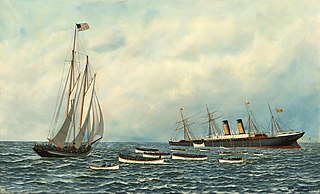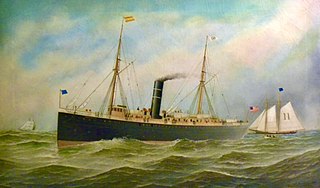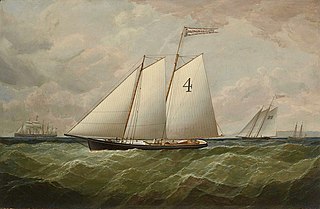Isaac Webb, was a 19th-century shipbuilder, owner and founder of the Isaac Webb & Co. shipyard. He was one of the founders of shipbuilding in the United States.

Jacob Bell was a shipbuilder, and founder of the Brown & Bell shipyard in New York City. His company built the first two ocean steamers launched in New York, as well as one of the earliest clipper ships, the Houqua.

Alexander M. Lawrence was the last of the 19th-century sailing schooners to be in the New York pilot boat service as a station boat. She was one of the largest and fastest in the Sandy Hook fleet. She was built to take the place of the New York pilot-boat Abraham Leggett, No. 4, that was hit by the steamship Naples, in 1879. Her boat model won a medal at the 1893 Chicago World's Fair illustrating the perils of the pilot-boat service. In the age of steam, the Lawrence was sold by the Pilots' Association to the Pacific Mining and Trading Company in 1897.

The Phantom was a 19th-century Sandy Hook pilot boat built in 1867 from the designs by Dennison J. Lawlor. The schooner was considered a model for her type with a reputation for being very fast. She helped rescue the passengers on the steamship SS Oregon when it sank in 1886. She was one of the pilot-boats that was lost in the Great Blizzard of 1888. The Phantom was replaced by the pilot-boat William H. Bateman.

The Thomas S. Negus was a 19th-century two-masted Sandy Hook pilot boat, built by C. & R. Poillon shipyard in Brooklyn in 1873 for the New Jersey maritime pilots. She was built to replace the pilot boat Jane, No. 1, which sank in early 1873. She was the winner of a $1,000 prize at the Cape May Regatta in 1873. She was named for Thomas S. Negus, president of the N. J. Pilots' Commissioners. In 1897, she left the pilot service to prospect for gold during the Klondike Gold Rush.

The Ezra Nye was a 19th-century pilot boat, built in 1859 by the Wells & Webb shipyard in Greenpoint, Brooklyn for a group of New Jersey and Sandy Hook Pilots. She was one of the pilot-boats that was in the Great Blizzard of 1888, that was one of the most severe blizzards in American history. In 1896, in the age of steam, the Ezra Nye along with other pilot boats, were replaced with steamboats.

The John D. Jones was a 19th-century Sandy Hook pilot boat, built in 1859 at the Van Deusen shipyard in East River for a company of New York Sandy Hook pilots. She was one of the finest vessels of her class. She was replaced by the pilot-boat Widgeon, when the Jones sank in a collision with the steamer City of Washington in 1871.
The Ariel Patterson, was a 19th century Sandy Hook pilot boat built in 1864 for a group of New York Pilots. She was built by the shipbuilder Ariel Patterson. After nineteen years of service she was struck and sank off Sea Bright, New Jersey, by the steamer Commonwealth, in 1883. She was raised and purchased by the Coast Wreaking Company.

The James M. Waterbury, was a 19th-century Sandy Hook pilot boat built in 1843, at Williamsburgh, Brooklyn for a group of New York Pilots. She helped on many of the rescues along the New York Harbor. One of last reports of the Waterbury, was in 1867 when seaman James Roach fell overboard and was drowned off Fire Island.

The David Carll, was a 19th-century pilot boat, built in 1885 at the David Carll shipyard in City Island, New York. She was named in honor of David Carll, a well-known City Island shipbuilder. The David Carll, was considered to be among the fastest schooners in the fleet. She was built to replace the Mary E. Fish, that was run down and sank by the schooner Frank Harrington in 1885. She was one of the pilot boats that survived the Great Blizzard of 1888. The David Carll, was lost at sea in 1893.
Augustus Van Pelt was a 19th-century New York Sandy Hook maritime pilot. He was one of the oldest and most famous Sandy Hook pilots. He was captain of the pilot boat Isaac Webb, for 19 years. His son, Frank P. Van Pelt was also a well-known Sandy Hook Pilot.

The Abraham Leggett, was a 19th-century New York pilot boat built by Daniel Westervelt at the Westervelt & Co. shipyard. She helped transport New York City maritime pilots between inbound or outbound ships coming into the New York Harbor. In 1866, Pilot Michael Murphy was on the Leggett, when the bark Emilie, ran into the pilot boat. In 1879, the Leggett, was hit and sank by the steamship Naples, from Liverpool. She was replaced by the pilot boat Alexander M. Lawrence.

Charlotte Webb was a 19th-century New York City pilot boat built in 1865 at the Webb & Bell shipyard to take the place of the James Funk, that was destroyed by the rebel Tallahassee during the Civil War. She survived the Great Blizzard of 1888, but was run down by the French steamship La Normandie in 1889. She was replaced by the pilot boat George H. Warren.
The James Gordon Bennett, was a 19th-century two-masted pilot boat, built in 1870 at the Lawrence & Foulks shipyard. She was named in honor of James Gordon Bennett, Jr., publisher of the New York Herald. She went ashore in 1893 and was rebuilt at the C. & R. Poillon shipyard. In 1897, the James Gordon Bennett was bought by Miller J. Morse of the Atlantic Yacht Club and made into a yacht. He changed her name to Hermit. The New Jersey pilots purchased her in 1901, to replace the David T. Leahy, that was run down by the steamship Alene. The Hermit sank in 1906, when the steamship Monterey ran into her.

The Enchantress was a 19th-century Sandy Hook pilot boat built in 1851 by John Maginn who named her after one of the cast in the opera The Enchantress. She was launched from the Westervelt & McKay shipyard. The Enchantress was one of the oldest pilot-boats in the service. She was Cornelius Vanderbilt's favorite pilot boat. The Enchantress went down with all hands in the Great Blizzard of 1888. The pilot boat James Stafford was built to replace her.
The Blossom, was a 19th-century Sandy Hook pilot boat built for the New York pilots around 1837. She helped transport maritime pilots between inbound or outbound ships coming into the New York Harbor. In 1839, she came across the Slave ship La Amistad. In 1840, there were only eight New York pilot boats, the Blossom being No. 5. Pilot Thomas Freeborn of the Blossom boarded the packet ship John Minturn and tried to guide the ship in bad weather. He was one of thirty-eight passengers that died near the Jersey Shore in 1846.

The George H. Warren was a 19th-century pilot boat built in 1882 by Porter Keene at Weymouth, Massachusetts, to replace the Edwin Forrest, No. 4, which was sold to the Pensacola, Florida pilots. The George H. Warren, originally belonged to the Boston pilot fleet but in 1889, she was purchase by a group of New York pilots. She and her crew were lost in the great blizzard of 1895.
The E. K. Collins was a 19th-century Sandy Hook pilot boat built in the early 1840s. She was named for the American shipping magnate Edward Knight Collins. During a winter storm, the Collins ran ashore on the outer bar of Fire Island in 1856.
The Gratitude, was a 19th-century Sandy Hook pilot boat built in 1824 by Brown & Bell for New York pilots. She helped transport maritime pilots between inbound or outbound ships coming into the New York Harbor. In 1839, she had a narrow escape from the slave ship La Amistad. In 1839, the Gratitude No. 3, was shipwrecked when a hurricane swept the New York coast. The New Jersey Pilot Boat John McKeon was lost in the same storm.













